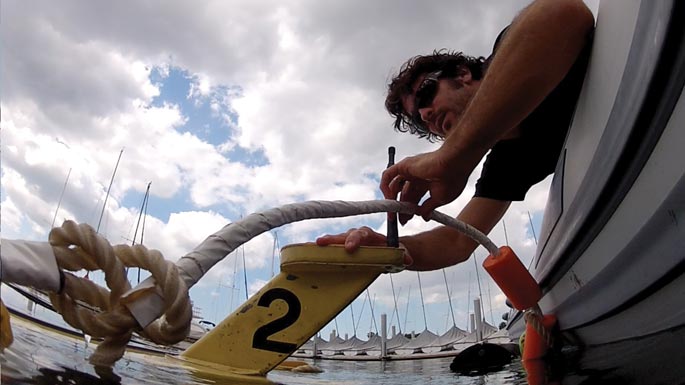Feature
Tweeting Tavros
| USF News

Brian Gregson, a biotechnologist at the College of Marine Science, demonstrates Tavros.
Photo by Katy Hennig | USF News
The latest bright yellow underwater robot patrolling the Gulf of Mexico and reporting information to USF marine scientists has taken to Twitter.
@Tavros02 joined the university's fleet of space-age vehicles in March and immediately began tweeting its coordinates, temperature and depth of the waters and other important information to followers.
USF marine science engineer David Fries worked with a team at the College of Marine Science to develop the unique marine observing and reporting system.
Unlike other underwater robots which wirelessly report ocean conditions back to researchers on land, the solar-powered Tavros vehicle can independently analyze water samples, compile the data and convert that information into a Twitter message. Fries and his team have built a series of the vehicles, but for now, only @Tavros02 tweets.
"This is a really exciting area of machine intelligence," Fries says. "We were interested in getting machines taking in data and, like humans have processed that data in the past, tweeting it back to us intelligently. We wanted to figure out how we could have them objectively communicate data without human input. Using Twitter linked to artificial intelligent programs allows us to do that and distribute to a large user group."
Fries has spent more than a decade working on the underwater sensing technology. Following the 2010 Deepwater Horizon oil spill, he was awarded a National Science Foundation grant to take the technology further.
Three things make the Tavros (Greek for "bull" and an acronym for The Autonomous Vehicle and Remotely-Operated Sensing) robots special. First, they are powered by solar cells instead of batteries which need to be recharged regularly. Second, the robots can analyze water on the spot — without a lab — and wirelessly transmit that data back to scientists. And third, they can report the data in a 140-character Tweet allowing scientists to interpret what is happening in real time.
Autonomous underwater vehicles can be programmed to follow a specific route and dive thousands of feet under water to test conditions such as temperature, currents, salinity, microscopic algae and droplets of oil at various depths. The robots can be used for routine surveillance, specific environmental challenges and to monitor ports for security.
Gary Hendrick, a mechanical engineer who has been part of the Tavros project, says the key to taking the robot communications to the social media level was to build in a programming bridge which converts key data, such as water temperature and salinity, to written language.
For now, the robots report on data they collect, but the team is working on processing the data within the vehicle and translating that data into phrases that address what people really want to know: Are the conditions good for fishing? Is there a red tide bloom developing? Is there oil in the water?
That capability, researchers say, is not far off.